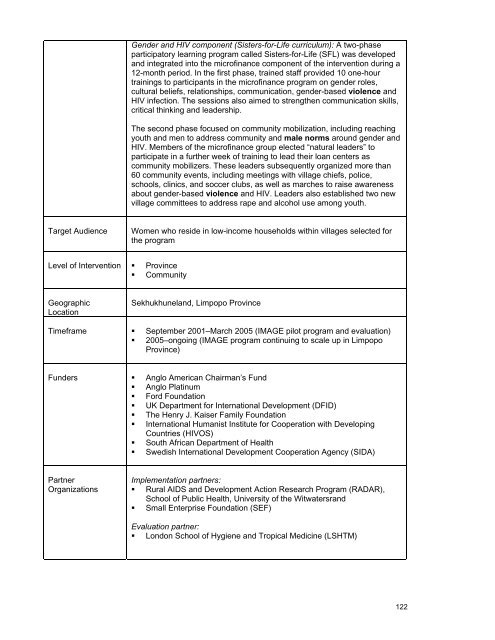Implementing Multiple Gender Strategies to Improve HIV and ... - ICRW
Implementing Multiple Gender Strategies to Improve HIV and ... - ICRW
Implementing Multiple Gender Strategies to Improve HIV and ... - ICRW
Create successful ePaper yourself
Turn your PDF publications into a flip-book with our unique Google optimized e-Paper software.
<strong>Gender</strong> <strong>and</strong> <strong>HIV</strong> component (Sisters-for-Life curriculum): A two-phase<br />
participa<strong>to</strong>ry learning program called Sisters-for-Life (SFL) was developed<br />
<strong>and</strong> integrated in<strong>to</strong> the microfinance component of the intervention during a<br />
12-month period. In the first phase, trained staff provided 10 one-hour<br />
trainings <strong>to</strong> participants in the microfinance program on gender roles,<br />
cultural beliefs, relationships, communication, gender-based violence <strong>and</strong><br />
<strong>HIV</strong> infection. The sessions also aimed <strong>to</strong> strengthen communication skills,<br />
critical thinking <strong>and</strong> leadership.<br />
The second phase focused on community mobilization, including reaching<br />
youth <strong>and</strong> men <strong>to</strong> address community <strong>and</strong> male norms around gender <strong>and</strong><br />
<strong>HIV</strong>. Members of the microfinance group elected “natural leaders” <strong>to</strong><br />
participate in a further week of training <strong>to</strong> lead their loan centers as<br />
community mobilizers. These leaders subsequently organized more than<br />
60 community events, including meetings with village chiefs, police,<br />
schools, clinics, <strong>and</strong> soccer clubs, as well as marches <strong>to</strong> raise awareness<br />
about gender-based violence <strong>and</strong> <strong>HIV</strong>. Leaders also established two new<br />
village committees <strong>to</strong> address rape <strong>and</strong> alcohol use among youth.<br />
Target Audience<br />
Women who reside in low-income households within villages selected for<br />
the program<br />
Level of Intervention • Province<br />
• Community<br />
Geographic<br />
Location<br />
Sekhukhunel<strong>and</strong>, Limpopo Province<br />
Timeframe • September 2001–March 2005 (IMAGE pilot program <strong>and</strong> evaluation)<br />
• 2005–ongoing (IMAGE program continuing <strong>to</strong> scale up in Limpopo<br />
Province)<br />
Funders • Anglo American Chairman’s Fund<br />
• Anglo Platinum<br />
• Ford Foundation<br />
• UK Department for International Development (DFID)<br />
• The Henry J. Kaiser Family Foundation<br />
• International Humanist Institute for Cooperation with Developing<br />
Countries (<strong>HIV</strong>OS)<br />
• South African Department of Health<br />
• Swedish International Development Cooperation Agency (SIDA)<br />
Partner<br />
Organizations<br />
Implementation partners:<br />
• Rural AIDS <strong>and</strong> Development Action Research Program (RADAR),<br />
School of Public Health, University of the Witwatersr<strong>and</strong><br />
• Small Enterprise Foundation (SEF)<br />
Evaluation partner:<br />
• London School of Hygiene <strong>and</strong> Tropical Medicine (LSHTM)<br />
122
















